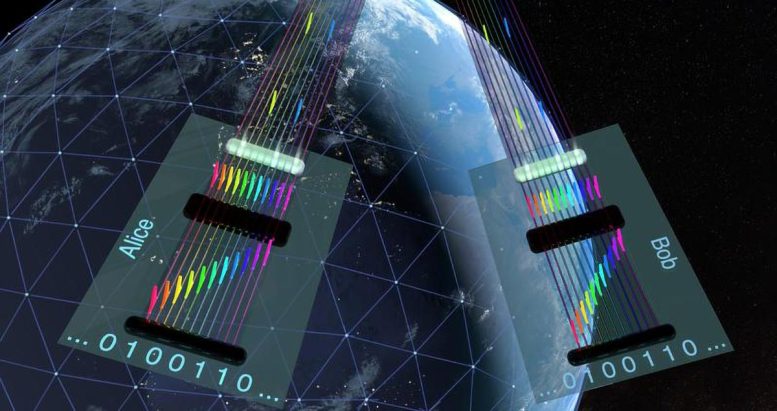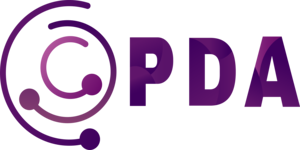
By Leibniz University Hannover February 14, 2025
Collected at: https://scitechdaily.com/quantum-encryption-breakthrough-uses-light-and-color-to-create-an-unhackable-internet/
As quantum computers threaten traditional encryption, researchers are developing quantum networks to enable ultra-secure communication.
Scientists at Leibniz University Hannover have pioneered a new method using light frequencies to enhance quantum key distribution. This breakthrough reduces complexity, cuts costs, and paves the way for scalable, tap-proof quantum internet infrastructure.
The Rising Threat to Data Security
The future of internet security faces a major challenge: quantum computers could eventually break even the strongest encryption used today, making sensitive data vulnerable. To counter this threat, researchers worldwide are working on quantum networks — systems that leverage the principles of quantum mechanics to enable ultra-secure communication.
When fully developed and globally interconnected, these networks will form the quantum internet, providing encryption that cannot be intercepted or decoded. However, widespread implementation remains difficult due to high costs, significant energy demands, and the complexity of the required technology.
A Novel Approach to Quantum Encryption
At Leibniz University Hannover’s Institute of Photonics, two researchers are tackling this challenge with a new approach. They have developed an advanced method for entanglement-based quantum key distribution using frequency-bin coding — a technique that encodes quantum information into different light frequencies (colors). This method not only enhances security but also improves resource efficiency.
“Our approach could enable quantum networks to be scaled up in the future while using fewer resources to connect higher numbers of users over greater distances,” explains Prof. Dr. Michael Kues, head of the Institute of Photonics and a member of the board of the PhoenixD Cluster of Excellence at Leibniz Universität Hannover. Research into optical technologies and photonic quantum bits is one of the university’s key research areas.

Advantages of Frequency-Based Quantum Key Distribution
Implementing entanglement-based quantum key distribution using frequency as a degree of freedom has two advantages. “Firstly, compared to polarisation, frequency is very robust against noise, which environmental factors such as temperature fluctuations and mechanical vibrations in the optical fibers used induce and disturb the key transmission,” says Anahita Khodadad Kashi, a doctoral student at the Institute of Photonics. “The second advantage is that by using the frequency, we were able to reduce the complexity of the process and thus also the costs,” says Khodadad Kashi.
Cutting Costs and Increasing Security
The researchers have succeeded in measuring the quantum states of the light particles using only one detector instead of four highly sensitive photon detectors. To carry out the four measurements required, they used a method called frequency-to-time transfer, which maps frequency components into the photon’s arrival time at the detector. Kues says that this reduced the costs for the standard telecommunications components from around 100,000 Euro to a quarter of that amount. “In addition, the vulnerability to detector attacks diminishes, and the system becomes more secure,” says Khodadad Kashi.
Scaling Up Quantum Networks
The method uses not just one but several channels simultaneously. This so-called adaptive frequency division multiplexing also increases the key distribution rate without the need for additional technical devices. “With this approach, the performance of the quantum network adapts itself dynamically to the current load,” says Khodadad Kashi. “In the future, our approach will enable dynamic, resource-minimized quantum key distribution between multiple users. This could make quantum networks scalable,” says Kues. “Quantum networks will be an important building block for making critical IT infrastructure more secure, for example, in the banking and healthcare sectors.”
The Future of Quantum Communication
Kues sees a need for further research into the interaction of nanophotonics with quantum optics in order to develop additional methods and components for generating a wide range of quantum states for the multidimensional coding of quantum information. “With the development of quantum networks, we will experience a new quality of connectivity, capacity, range, and security of quantum communication in the future,” says Kues.
Reference: “Frequency-bin-encoded entanglement-based quantum key distribution in a reconfigurable frequency-multiplexed network” by Anahita Khodadad Kashi, and Michael Kues, 16 January 2025, Light: Science & Applications.
DOI: 10.1038/s41377-024-01696-8
The research was funded by TÜV Nord / Alter Technology, the Federal Ministry of Education and Research (BMBF), and the European Research Council (ERC). The research results were published in the journal Light: Science & Applications.

Leave a Reply